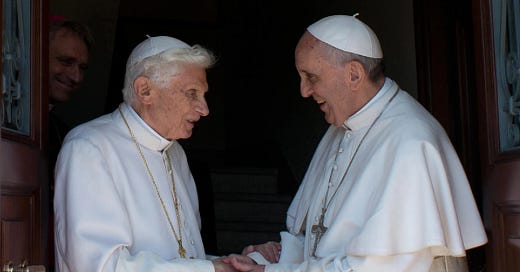The false idea of rigid continuity
As a young adult Catholic, I believed, with a lot of certainty, that Church teaching never changed. Catholicism teaches the same thing today, yesterday, and forever. Sometimes pastoral application of a doctrine could be tweaked, but there could never be any real discontinuity between past and present teachings. I understood this idea in terms of Pope Benedict’s teaching juxtaposing a “hermeneutic of discontinuity” with a “hermeneutic of continuity.”
Except, despite my certainty, I was wrong. Not only about that idea in general, but even about what Pope Benedict taught. He didn’t champion a hermeneutic of continuity, rather, he proposed a “hermeneutic of reform.”
Vatican II theologian, Shaun Blanchard, wrote an excellent article about the development of doctrine titled, The Reform was Real: Continuity and change at Vatican II.
Here’s an excerpt, but the entire thing is well worth the read.
Ratzinger was understood to believe that Vatican II, if read correctly, did not and could not change doctrine; it could only update pastoral strategies or amend Church discipline. Figures such as First Things editor Richard John Neuhaus, neither a traditionalist nor an enemy of the council, fell into this unhelpful continuity-discontinuity binary. He slammed the Jesuit historian John O’Malley’s What Happened at Vatican II, a moderate and judicious overview of the council that takes seriously both its deep continuities with previous councils and its striking innovations. Neuhaus condemned O’Malley’s work as belonging to the “the Lefebrvrists of the left”: just like SSPX, these progressives believed the council brought “a radical break from tradition” and “in effect, a different Catholicism.”
Neuhaus’s reaction to O’Malley’s book represented a perspective common among conservative U.S. Catholics, and predominant in many seminaries and campus ministries. Media organizations like EWTN and a host of new apologists and popular speakers often promote this kind of narrative. Surely one of the main reasons that Pope Francis shocked so many American Catholics was that they had been formed by this catechesis of rigid continuity. I was well schooled in this kind of catechesis as a high-school and college student: we Catholics stay the same; the Protestants change. That was the party line. And the secular world changed even more, because it was in thrall to the “dictatorship of relativism.” I recall a meme that summed up this simplistic worldview: a skeleton, sitting on a park bench, above which appeared the words “still waiting for the Catholic Church to change.” This was intended as a boast, not a criticism. When I first explored Vatican II as an undergraduate, I began wondering if I had been misled.
[…]
Change and discontinuity are certainly manifest in both these cases. But if Benedict’s hermeneutic of reform is correct, that is as it should be. Contrary to those who fear that the magisterium is undermined by any hint of discontinuity, the ability to change, self-correct, and sometimes even repent increases the credibility of the Church.



